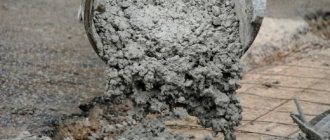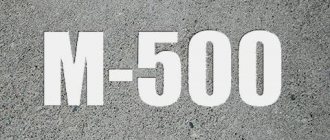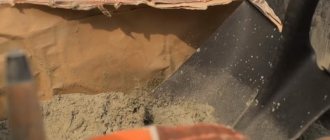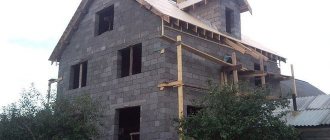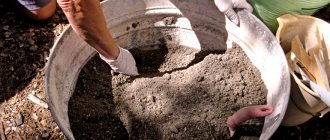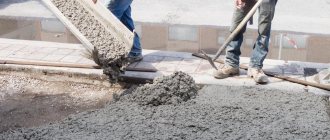Concrete 100 is widely used when carrying out a wide range of repair work. This material does not require the use of special tools or devices. To lay concrete M 100 you do not need to put in a lot of effort; the material fits well into any shape. The building material has little resistance to load influences, for this reason it is used for minor stages. For example, preparatory work before the construction of the foundation; it will serve as a concrete pad that creates a barrier for cement laitance and will protect the lower parts of the reinforcement frame from corrosion.
Composition of concrete M 100
In order to obtain high-quality concrete, the manufacturing technology must be strictly followed. Lean concrete M 100 includes a minimal amount of cement, which serves to hold the aggregate together. It is also recommended to adhere to the general recommendations for the component and proportional part. In many ways, the composition of the mixture will depend on its purpose and compliance with the future design. Concrete grade M 100 will contain less cement compared to a higher grade. It is recommended to select the components that make up the concrete mixture, guided by practice-tested recipes and current standards. According to the norms and requirements of building regulations, the mixture is prepared using the following components:
- Portland cement, various brands of cement powders are used, which will serve as binding components for all the ingredients of the mixture;
- washed river sand and sand-gravel mixture;
- crushed stone, fillers based on limestone and the middle fraction of granite or gravel chips are also used;
- The dry mixture is poured with water and mixed well.
Approximate composition of concrete M 100 per 1 m3:
- water 0.23 m3;
- sand 0.58 m3;
- crushed stone 0.8 m3;
- cement M 400 250 kilograms.
When asked how much cement is in concrete m100. You can answer that 1 m3 includes 200-250 kg of dry component.
Special substances are added to the M 100 concrete solution that affect the performance of the building material.
Price
Determining the cost of the material is influenced by:
- price per brand of cement and fillers;
- electricity costs (if the solution is mixed using a concrete mixer);
- period of work;
- delivery costs to the construction site;
- construction region.
For example, the price of 1 m3 of M100 concrete in Moscow is 2600-3300 rubles. Most often, the concrete mixture is sold along with transportation. Transport costs are 400-700 rubles per 1m3. Since unloading the material takes time, and the machine is waiting for complete unloading at this time, you will have to pay for the wait - approximately 1000-1500 per hour.
Specifications
Concrete M 100 has a certificate of conformity, which has the following performance characteristics:
- Density qualities vary from 2.37 t/cub.m to 2.4 t/cub.m. The indicators depend on the dimensions of the filler used.
- Low strength, the material is able to withstand loads that amount to 0.098 tons/sq.cm of surface area;
- Frost resistance, where F50-F100 indicators indicate the absence of crack formation on a monolithic surface from 50 to 100 freezing cycles.
- Quality of mobility. Concrete solutions have good elasticity and compaction, especially grades P2-P4.
- Waterproof qualities correspond to level W2-W4. This feature creates a protective barrier that prevents the loss of cement laitance.
- The hardness indicators are Zh2-Zh4. This material retains its shape when poured, which makes the work process easier.
The quality of frost resistance and water resistance depends on the size of the filling material. Granite, gravel, expanded clay or limestone fillers are used, which affects the performance indicators.
Concrete M 100, what kind of building material is it? Interpretation of concrete M 100: the letter “M” means grade, and 100 means strength indicators. This solution belongs to concrete class B 7.5 according to the strength characteristics of SNiP. The letter “B” denotes a number that is responsible for the value of the guaranteed strength of a concrete product in compression and axial tension in MPa, with a probability of 95%.
The specific gravity of compositions based on various fillers will also differ:
- a mixture based on expanded clay granules and shell rock will be 0.5-1.8 tons. This material belongs to lightweight construction mixtures;
- 1 m3 of heavy mortar includes gravel or crushed stone with a coarse fraction and weighs 1.8-2.3 tons;
- the specific gravity of especially heavy compositions has metallic inclusions, the weight is 3 tons.
Data that characterizes the density of the concrete mixture is used in calculations. For the construction sector, other indicators are used - the volumetric mass of grade M 100 is 1.84 tons.
Ultrasound technique
Ultrasonic testing methods are also in demand to preserve the integrity of the concrete mass. The method involves the use of an ultrasonic transducer, which is applied to the controlled structure and ensures reliable acoustic contact. The speed of propagation of ultrasonic vibrations in the mass determines its strength.
The technology involves the following types of sound:
- through, used for columns and beams, in which sensors are installed on opposite sides of the structure;
- transverse, used for panels, floor slabs, in which the wave converter is located on the side of the control zone.
Ultrasonic testing equipment includes special sensors and an electronic module.
The strength grade of concrete is an average strength indicator, and the concrete class is an indicator of guaranteed strength
The speed of ultrasonic wave movement is affected by:
- Array density.
- Uniformity of composition.
- Elasticity.
- Presence of cavities, cracks, local defects.
The device converts ultrasonic vibrations into digital values of characteristics.
Proportions for manufacturing
When making concrete mortar, special attention should be paid to the exact parts of the ingredients. Experts recommend taking cement grades M 400 and M 500. For example, for the ratio of the constituent elements, take one part of M 400 cement and 4.6 parts of sand and 7 crushed stone.
When the M 500 grade of cement mortar is used, then the proportional number will look like this: 1 to 5.8 to 8. In the description of the M 100 concrete standards, the amount of water is not indicated. It is recommended to add water until the mass becomes plastic; a very liquid mixture is not permissible.
When large volumes of concrete mixture are produced, it is better to use a concrete mortar mixer. To do this, place dry ingredients in a container, mix, and then add water, then mix again until a homogeneous mass is formed. Next, to obtain the desired consistency of the solution, add the rest of the water.
The volumetric weight of concrete M 100 will depend on the proportions of the filler and the amount of water spent, the presence of voids and the quality of the batch. At enterprises, concrete mixtures M 100 are produced according to GOST 7473-94 standards (concrete mixtures).
Features of application
Differences in the percentage of the components of the solution give rise to differences in the properties and characteristics necessary for one type of work or another. Thus, the use of concrete depending on the brand is expressed in the table.
| Brand | Scope of application |
| M 100 | The so-called “skinny concrete”. It is used in the form of preparation in the construction of roads, for the installation of curbs, in the field of preparation, in anticipation of pouring the foundation and reinforcement. |
| M 150 | A type of lightweight concrete for auxiliary needs in construction, production of floor screed, laying paths. Allowed as a foundation for low-weight structures. |
| M 200 | A fairly common brand due to its increased stability. Suitable for most types of foundations, blind areas, arrangement of platforms, pedestrian paths, construction of concrete flights of stairs, retaining walls, leveling floor screeds. |
| M 250 | Used for various types of foundations, when equipping blind areas, pouring platforms, concrete stairs. They are also used as bases for fences and tiled floors with light loads. |
| M 300 | A fairly popular composition is a practical sales leader. It is used for pouring foundations of any degree of complexity, making walls, ceilings, fences, producing concrete platforms, constructing concrete stairs, blind areas. |
| M 350 | The brand has decent water resistance, so it is suitable for making swimming pool bowls. It is used under extreme loads - when equipping foundations for multi-storey buildings, manufacturing monolithic walls, supports and other load-bearing systems. The main material for the production of reinforced concrete products, airfield slabs, pile-grillage reinforced concrete structures, crossbars, tiled floors. |
| M 400 | A characteristic feature is relatively fast setting and high price. Due to these characteristics, it is rarely used in home construction. Most often it is part of the structures of bridges, various kinds of hydraulic structures, and reinforced concrete products for special purposes. Indispensable for public facilities with special safety requirements - water parks, shopping centers, indoor swimming pools, and so on. |
| M 450 | In private construction, the use of this brand is inappropriate. The application is associated with the production of specialized reinforced concrete structural elements, the requirements for which are regulated by design documentation. Necessary for the construction of platinums, bank vaults, bridges, subways, and dams. |
| M 500 | This brand is used in the design of hydraulic structures, subways, construction of bank vaults and other structures. Not used for domestic purposes. |
Read with this
- Waterproofness of concrete
- Concrete hardening time depending on ambient temperature
- Liquid plasticizer or liquid soap?
- Save on concrete
- Concrete weight
- Is it possible to pour concrete in water?
- GOST 31360-2007. non-reinforced wall products made of autoclaved cellular concrete. technical specifications
- How to calculate the cubic capacity of concrete for a foundation
- High-strength whitemix mixtures
- How to speed up concrete hardening
Concrete production
Concrete mortar is prepared from available ingredients; this mixture will be indispensable when performing various construction stages. Manufacturing technology must be followed using the highest quality components. Concrete grade M 100 contains the following filler options:
- gravel;
- crushed limestone with a fraction from 5 to 20 mm;
- granite fillers;
- There is no need to add stabilizers and modifiers.
Our advantages
Manufacturer with reputation and reliable production.
More than 2000 satisfied customers. RBU (Germany) > 80 m3/hour each.
Guarantee of high quality raw materials and products
Control is carried out at all stages by our own certified laboratory
Accuracy and timeliness of deliveries.
Weight control. Professional logistics.
Uninterrupted and convenient delivery to any area. Pickup.
Favorable geographical location of production sites.
Favorable prices. Any form of payment.
Without intermediaries. Discounts up to 20% on purchase volume.
High level of service and 100% mutually beneficial cooperation.
Free consultations and visits. We build long-term relationships.
Option for obtaining 1 m3 of solution
To do this you will need the following materials and tools:
- capacity;
- bucket;
- shovel;
- hoe;
- 200 kg of cement;
- 750 kg of sand;
- 1200 kg of crushed stone;
- water 180 l.
All building materials are poured into a container and mixed well with a hoe. First add 10 liters of water and mix again, then gradually pour in all the water. There is another kneading method. First, water is poured in, and then mixed with cement, then with sand.
Where is it used?
Concrete M 100, can withstand light loads, where is it used? The purposes of using the material are as follows:
- during preparatory work during pouring of the foundation;
- formation of underlying bases for road surfaces;
- for fixing curbs;
- construction of platforms for installation of reinforced concrete elements;
- concrete M 100 is often used during rough work in non-residential buildings, where pouring is carried out directly onto the soil;
- when concreting floors in basements and cellars;
- landscaping;
- interior decoration.
The specific use of the solution involves laying it in a thin layer on the surface layer of soil or compacted sand cushion. If necessary, the mixture is strengthened with iron reinforcement, which increases its strength qualities. The main characteristics of concrete M 100 must be indicated in the quality certificate. Therefore, you should carefully study the accompanying documents that confirm the quality. Concrete M 100 B 7.5 is used in special cases where serious performance qualities are not required, and the emphasis is on the low cost of the product.
Despite the low strength indicators, M 100 concrete is popular among consumers, for which it is used as described above. In addition, you can point out that pouring the mixture will not require much effort. After the material hardens, a reliable base will be formed that will retain its strength for a long time.
It is strictly not recommended to use class B 7.5 concrete, which is also called “skinny”, in structures prone to high loads. This type is intended for use when laying reinforced concrete elements.
STRENGTH
Strength (as well as deformation and other properties) largely depends on the ratios and properties of the materials included in the concrete, methods of laying and processing the mixture, age at the time of loading, dimensions of the concrete element, temperature and humidity of the environment in which the concrete is located, and etc.
The compressive strength of concrete samples depends on the absolute and relative (the ratio of the height of the sample h to its thickness d) dimensions of the sample. This is explained by the action of friction forces arising during compression between the surfaces of the sample and the press plates. These forces prevent transverse deformations and increase the breaking load. The smaller the h/d ratio, the greater the influence of friction forces. For example, for samples that have the same dimensions in plan but different heights, with h/d = 0.5 the destructive load ranges from 1.5 Rcub to 2.5 Rcub, and with h/d = 4 - from 0.75 Rcub to 0.95 Rcube, where Rcube is the destructive load for the cube (h/d =1). The influence of friction forces also changes with changes in the absolute dimensions of the samples—concrete cubes.
The strength of concrete in structures is close to the strength of concrete obtained when testing a prism, with the ratio h/d=4÷8. The compressive strength of a prism with a cross section of 20X20 cm and a height of 80 cm is called the prismatic strength Rpr. It can be calculated using formulas (a) and (b), substituting in them instead of standard resistances - the strength limits of concrete.
When concrete is compressed, microcracks (breaks) are formed, which are detected using strain gauges, ultrasonic and other testing methods at relatively low stresses Rt, equal to 0.3-0.4 Rpp for very weak concrete, and 0.65-0.75 for very strong concrete. Rpr. Visible cracks appear at stresses exceeding 0.7 Rpr.
The effect of the duration of load application on strength depends mainly on the magnitude of the stresses. If the stress in concrete is less than Rt, then long-term application of load does not reduce (and according to some data slightly increases) the tensile strength of concrete compared to concrete that has not been subjected to long-term loading and tested at the same age. If the stresses exceed the long-term resistance of concrete Rdl = 0.8 Rpr, then the prolonged action of the load causes its destruction.
Repeated application of a load with a large number of loading cycles leads to destruction if the maximum stress at this load exceeds Rt, i.e. for strong and high-strength concrete more than 0.5-0.75 Rpr.
Various factors have different effects on the strength of concrete in compression Rpr, tension Rp and shear Rcr, therefore the relationships between these indicators of concrete strength vary widely. The ratio Rpr/Rp is for different concretes in the range from 5 to 16, and usually (but not necessarily) increases with increasing grade of concrete.
Resistance of concrete to tension during bending with comparable sample sizes Rр.и=1.8÷2.2 Rр; in this case, Rр.и is calculated using the conditional (for elastoplastic bodies) formula for the resistance of materials Rр.и=M:W. When bending, concrete collapses in the stretched zone. Concrete destruction in a compressed zone is possible only in reinforced concrete beams.
Shear resistance of concrete grades 100-300 Rav=0.18÷0.27 Rpr with a length of cutting areas of the order of 15-20 cm; on average Rcp=0.22 Rpr.
Design grades of concrete for compressive strength and tensile strength are characteristics of concrete strength assigned during design. The standards establish the following design grades of concrete for compressive strength: 15, 25, 35, 50, 75, 100, 150, 200, 300, 400, 600, 800. Grades 15-75 apply only to concrete with porous aggregates, and grades 400 -800 - only for heavy concrete.
The correspondence of the actual strength of concrete to its design grade must be established by testing concrete cubes; When assessing test results, one should take into account not only the average strength limits of concrete, but also its coefficients of variability.
The standard cubic compressive strength of concrete Rн is assigned taking into account the variability of concrete strength and is taken equal to
where cу is the standard value of the coefficient of variability, equal to = 0.135 for heavy concrete and concrete with light aggregates, and = 0.18 for autoclaved cellular cement concrete. The standard prismatic strength of concrete is determined by the formulas:
for heavy concrete and concrete with porous aggregates:
| (A) |
for cellular concrete
| (b) |
The design resistance of concrete is determined by dividing its standard prismatic strength by safety factors. Safety factors for compression Kb.s when calculating according to the 1st group of limit states are assumed to be equal for heavy concrete and concrete on porous aggregates Kb.s = 1.20, and for cellular autoclaved cement concrete Kb.s = 1.50.
Advantages and disadvantages
Lightweight concrete grade 100 has the following advantages:
- The affordable cost of the building mixture significantly reduces costs.
- The reliability of the solution allows you to maintain the integrity of the finished surface when exposed to negative natural phenomena.
- The durability of concrete marking M 100 is due to technical and strength indicators that do not lose their properties for a long time. The specific gravity of concrete M 100 is approximately 2.494 tons per 1 m3.
- The mortar is safe; the raw materials included in the composition are environmentally friendly and do not have a negative impact on human health.
- Concrete M 100 is available and has excellent technical characteristics.
- Moisture resistance - the solution is not subject to destruction when exposed to a humid environment and is able to reliably protect reinforcement from corrosion.
- Wide range of applications - from road construction to house construction.
- Frost resistance - the material can withstand up to 50 stages of freezing and thawing. This type of solution can be used in any climatic conditions of our country.
The main positive feature of this brand of concrete is its moisture resistance and excellent interaction with the soil; this quality allows you to fill paths in gardens and parks, install fence posts, and carry out various preparatory work that involves direct contact with the soil cover.
Minuses
The main disadvantage of the concrete mixture is the low strength of the building material after hardening. After any base has been prepared, reinforcement is laid on the top layer of concrete screed M 100, and then further work is carried out with a mixture of a higher grade. With many positive qualities, lean concrete has the following disadvantages:
- there is a risk of crack formation that impairs the performance and integrity of the element;
- the strength characteristics are reduced; this feature does not allow the use of building materials for important work related to concreting.
To increase strength and reduce the risk of deformation, when preparing a concrete solution, emulsions based on bitumen are added to the composition.
Properties
The percentage of the main ingredients taken during mixing determines the characteristics of the concrete. They affect the class and brand of material.
Strength
This is the main property of raw materials. To determine the strength, a standard cube with an edge of 200 mm is made and tested in 2 ways:
- Destruction. Strength testing takes place in laboratory conditions. The cube is placed under a press and a load of tens of tons is applied to it. The resulting coefficient determines the grade of the material.
- Non-destructive effect. Concrete is influenced by rebound, ultrasound, and shock impulse. Then experts calculate indicators based on the results obtained.
Strength is also affected by the characteristics of cement and stone aggregate.
Density
This property is measured as a percentage and is always less than 100%. Depending on the indicators, the material is divided into 3 types:
- Lightweight (500-2000 kg/m3). If the density is up to 500 kg/m3, the concrete is called especially light. The material is created on the basis of fine or coarse porous aggregate. Lightweight raw materials are used in the construction of fences and load-bearing structures.
- Heavy. The density of the material is 2000-2500 kg/m3. To obtain it, coarse sand or hard rocks are added and used to create load-bearing slabs.
- Particularly heavy. This type includes reinforced concrete. Its density is above 2500 kg/m3. A type of concrete is made using steel, cast iron, barite, etc. The heavy type is used in the construction of special-purpose facilities, for example, nuclear power plants.
Heavy concrete The higher the density, the higher the strength.
Structure
Porosity is no less important an indicator than density. Based on their structure, there are 4 types of material:
- Fused (or dense). In the intergranular space there is a binder filler. Cast concrete is frost-resistant and moisture-resistant and is used in the production of load-bearing slabs.
- Large porous. In this type, the voids between the grains remain unoccupied.
- Porized. In the intergranular space, additives form gas or foam.
- Cellular. In this type of material, pores are specially created. To do this, a combination of pore-forming additives, a finely dispersed component and astringent compounds is used. Cellular concrete is used for the construction of thermal insulation structures and fences.
Cellular concrete Porosity does not mean a loss of strength of the material. To maintain this property, special substances are added.
Weight
The mass of the material depends on the characteristics of the filler. Based on specific gravity, raw materials are divided into 4 types, under its influence the mass of a cubic meter fluctuates:
- 0.5 t. This is the weight of especially light materials. They are used for thermal insulation: the cells occupy 85%;
- 0.5-1.8 t. This is a mass of lightweight concrete with or without porous aggregates;
- 1.8-2.5 tons. This is the weight of heavy materials with large aggregates (gravel, crushed stone). This type has a wide range of uses;
- 2.5-3 tons. The weight is determined by heavy fillers (metal, barite, etc.).
Water resistance
This property determines how much concrete is able to withstand moisture and not collapse. To determine water resistance, 2 samples of the material are made. One is crushed dry using a press and the strength is determined.
The second one is lowered into water and allowed to soak in moisture. Then the sample is placed under a press. With a softening coefficient of more than 0.8, the material is used for the construction of piers and dams. Concrete is divided into grades based on water resistance, with the marking indicating the level of liquid pressure during testing.
Frost resistance
The characteristics and properties of concrete include the material's ability to withstand the thawing and freezing of liquids. Water enters the pores, which freezes and then melts under the influence of external conditions.
Thermal conductivity
This property is to transfer heat arising on the surface of a material under the influence of external conditions. The thermal conductivity of concrete is higher than that of building bricks, but lower than that of steel.



